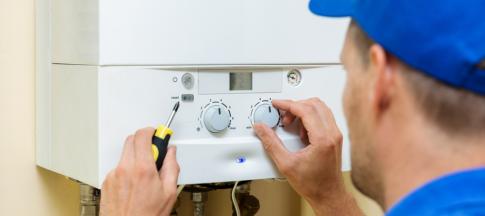
If you’re thinking of moving home, it’s worth seeing what kind of heating system the property uses. There’s a chance it may have oil-fuelled central heating. One big giveaway will be a large storage tank, probably in the garden.
These are common enough not to be unusual, but there are certainly pros and cons worth being aware of – both with the heating system, and the oil tank itself. Here we’ll look at some of the considerations to bear in mind with oil central heating.
Please note: For the purposes of this guide, we’re going to assume you’re not thinking of installing a new oil-fuelled system. Aside from being expensive to install from scratch, there are government plans to phase out high-carbon fossil-fuel heating systems within the decade.
What is oil-fuelled central heating?
Like gas, oil-fuelled central heating is a ‘wet’ system. It heats up water with an oil-fired boiler, which then flows to your radiators and hot taps.
The main difference with oil is that you don’t get a steady supply coming directly into your home from your provider. Rather, you need to store a quantity of oil in a tank, which you either buy or rent.
One of the main downsides of an oil-fuelled system is immediately apparent – you need a lot of space for the tank.
How does an oil storage tank work?
As they take up a lot of space, most people’s oil tanks are stored in their garden. They can also be stored in outbuildings such as a garage. Plus the oil needs to be delivered periodically, so it should also be easily accessible by lorry.
Tanks can either be single-skin or bunded. Single-skin tanks have just one layer for oil containment, meaning they tend to be cheaper, but less secure. Bunded tanks have a second layer of containment. There are different regulations regarding single-skin and bunded tanks, which we’ll look at below.
Most UK oil-fuelled systems run on kerosene. While research is being conducted into cleaner, more sustainable biofuel, this isn’t really an option at the time of writing.
The oil is sent to the boiler via pipes, and from then on, it works much like a gas central heating system. You’ll have thermostats which operate in the same way, and a timer with which you can control heating and hot water.
How much does oil cost?
According to consumer magazine Which?, the average annual cost of using heating oil for heating and hot water is £830. However, it’s worth noting that the cost of oil is variable, and tends not to be very steady. For example, the average cost of kerosene heating oil was 43p a litre in January 2017, but rose to 52p a litre over two years.
One of the few advantages of oil-fuelled systems is that, when the price of oil is low, you can stock up.
What else do I need to know about oil storage tanks?
Tanks should be well away from any combustibles, and kept in a way that minimises potential environmental impact.
Different regulations apply depending on where you live in the UK.
Regulations in England
If you’re having a new or replacement oil container installed, you have to meet England’s building regulations.
Your tank will need to be installed by someone registered with a ‘Competent Person’ scheme. They’ll perform a risk assessment, and may decide you need secondary containment – ie a bunded tank.
If your tank can store 3,501 litres or more, you’ll need to follow the regulations for businesses. Find out more about storing oil at GOV.UK.
For the technical specifications and regulations concerning where the tank should be placed, read OFTEC’s guide to domestic liquid fuel storage.
Different rules in Wales
Wales is the first country in the UK to require secondary containment for fuel tanks over 200 litres. In other words, if your tank can store 201 litres or more, you’ll need a bunded tank (although oil containers installed at homes before 15 March 2016 are exempt). This must hold at least 110% of the capacity of the inner tank. This is to reduce the risk of oil contamination to the environment.
You can read the Welsh government’s oil storage regulations here.
Building regulations in Scotland
The main difference in Scotland is that tanks which can store 2,501 litres or more must be bunded. Building regulations may also vary in Scotland. You can read the Building Standards regarding fuel storage at domestic properties online here:
Building regulations in Northern Ireland
Regulations in Northern Ireland are similar to those in England, and all tanks with a capacity greater than 3,500 litres should be bunded. You can read the full storage regulations here.
Do I need to maintain my oil tank?
While oil-fuelled systems are very efficient, they can become contaminated easily, and need to be properly maintained.
Your boiler needs a lot of cleaning, and contains perishable parts. For this reason, it should be serviced annually. According to the Heating Hub, this should cost you £120-£180 a year, depending on what needs to be replaced.
OFTEC also recommends servicing your oil tank and other equipment annually. It’s worth checking if your home insurance covers leaks or spills, and whether the policy has any limitations. Leaking fuel can be costly to clean up, and risks contaminating ground water.
Also check to see if your oil tank comes with a manufacturer’s guarantee. This means that, if something goes wrong within the life of the guarantee, the manufacturer should repair or replace the tank and shoulder the cost.
Bear in mind that if you have a single-skinned tank which no longer complies with regulations, the manufacturer isn’t obliged to pay for a bunded tank. Rather, they may offer an upgrade to a bunded tank for a discounted price.
How can I keep my oil tank secure?
As tanks are frequently kept outside and at a distance from the house, heating oil theft is a risk, and can prove very costly.
Here are a few top tips for preventing oil theft:
- Install a heating oil tank alarm: This will alert you if the oil level dips suddenly. This isn’t necessarily a preventative, so consider having a sign saying that there’s an alarm installed.
- Use a security camera or lights: CCTV, a motion-sensor light, or a video doorbell will alert you as to movement around the tank.
- Surround your tank with gravel: Quite a simple deterrent, the crunch of gravel around the tank may be enough to put opportunist thieves off.

